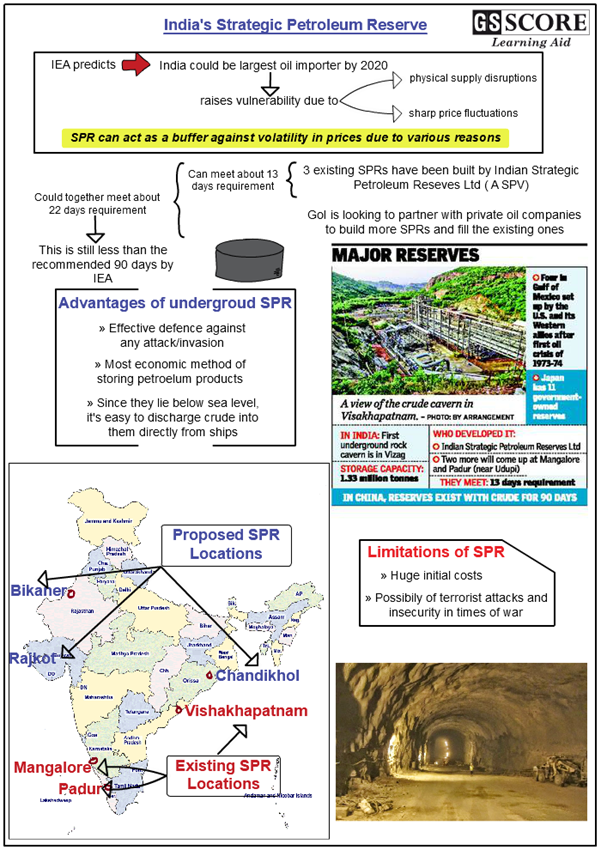

- The Indian government is looking forward to forge partnerships with private oil companies to build out its strategic petroleum reserves within the coming year
- As part of India’s evolving energy security architecture, India is seeking $1.5 billion of investments from global oil producers and traders to build additional emergency crude reserves that will act as a buffer against volatility in oil prices.
- The plan is to build underground caverns that can hold a combined 6.5 million tons of crude oil at three locations.
Issue
Context:
- The Indian government is looking forward to forge partnerships with private oil companies to build out its strategic petroleum reserves within the coming year
- As part of India’s evolving energy security architecture, India is seeking $1.5 billion of investments from global oil producers and traders to build additional emergency crude reserves that will act as a buffer against volatility in oil prices.
- The plan is to build underground caverns that can hold a combined 6.5 million tons of crude oil at three locations.
Background:
- Many major global oil consumers such as the US, China and Japan have built massive strategic reserves of oil over the years, and India too has embarked on the path in the last decade.
- Indian Strategic Petroleum Reserves Ltd., which was formed in 2006, has constructed 5.33 million tons of three strategic petroleum reserves in huge underground rock caverns at Visakhapatnam on the East Coast, and at Mangaluru and Padur on the West Coast.
- These facilities can meet about 10 days of India’s crude oil requirements. The government has approved new facilities recently that can provide additional supply for about 12 days.
- India has purchased crude oil to fill the caverns in Visakhapatnam in Andhra Pradesh and half of another facility in Mangalore in Karnataka, while leasing out the other half to Abu Dhabi National Oil Co.
- Indian Strategic Petroleum Reserves Ltd. is scouting investors to fill the caverns at Padur. It will hold road-shows in New Delhi, Singapore and London in October 2018 to draw investors for the new caverns as well as filling the Padur facility.
About:
Strategic petroleum reserve (SPR)
- They are typically state-funded oil reserves. These are essentially huge stockpiles of crude oil to keep the wheels of the country running in crunch situations.
- They are meant to tackle emergency situations and allow a country to tide over short-term supply disruptions. SPR is deemed essential because the government has to stay prepared with emergency stores of crude oil to tide over severe supply shocks of this critical fuel.
- International Energy Agency (IEA) members maintain emergency oil reserves equivalent to at least 90 days of net imports.
- The concept of building underground caverns to store oil is not new. In the US, the crude reserve is stored at four sites in the Gulf of Mexico. The world’s second largest emergency supply of oil is reported to be in Japan.
Global Crude Reserves
The US: The country’s Department of Energy’s Strategic Petroleum Reserve (SPR) is an emergency fuel storage that is the largest emergency supply in the world with the capacity to hold up to 727 million barrels. As of end-February 2015, the inventory was 691.0 million barrels, which was equivalent to about 37 days of oil at 2013 daily US consumption levels of 18.49 million barrels per day. The United States started the petroleum reserve in 1975 after oil supplies were cut off during the 1973-74 oil embargo, to tide over future temporary supply disruptions. The reserve is stored at four sites on the Gulf of Mexico, each located near a major centre of petrochemical refining and processing.
Japan: The country has the second largest emergency supply of oil with a reported capacity of close to 600 million barrels. The SPR is composed of two types of stockpiles — state controlled reserves at eleven different locations totalling 324 million barrels and privately-held reserves of petroleum held “in accordance with the Petroleum Stockpiling Law” of 129 million barrels. The Japanese SPR is run by the Japan Oil, Gas and Metals National Corporation.
China: The Chinese Strategic Petroleum Reserve consists of a government-controlled strategic reserve complemented by mandated commercial reserves. The planned state reserves of 475 million barrels plus the planned enterprise reserves of 209 million barrels are expected to provide around 90 days of consumption or a total of 684 million barrels.
European Union: In the European Union, according to Council Directive of 1968, all 27 members must have a strategic petroleum reserve within the territory of the EU equal to at least 90 days average daily internal consumption.
About SPR facilities in India
- India consumes approx.4 million barrels a day, of which about 80 per cent is imported, making it the world’s third-largest oil consuming nation in the world. The IEA predicts that by 2020, India could well be the largest oil importer, increasing the country’s vulnerability to threats of physical supply disruptions and to sharp price fluctuations.
- To ensure India’s energy security, the Government of India had decided to set up 5 million metric tons (MMT) of strategic crude oil storages at three locations namely, Visakhapatnam, Mangalore and Padur.
- These strategic storages would be in addition to the existing storages of crude oil and petroleum products with the oil companies and would serve as a cushion during any external supply disruptions
- These facilities together will help support 22 days of India’s crude oil requirements. However, the International Energy Agency (IEA) recommends 90 days. So, clearly, there is need to build more.
- Crude oil from the reserves is to be released by an empowered committee constituted by the government, in the event of any supply disruptions from abroad. These include any natural calamity or any unforeseen global event, leading to an abnormal increase in prices.
- In the 2017-18 budget speech, Finance Minister announced that two more such caverns will be set up Chandikhole in Jajpur district of Odisha and Bikaner in Rajasthan as part of the second phase.
- The construction of the Strategic Crude Oil Storage facilities is being managed by Indian Strategic Petroleum Reserves Limited (ISPRL), a Special Purpose Vehicle, which is a wholly owned subsidiary of Oil Industry Development Board (OIDB) under the Ministry of Petroleum & Natural Gas.
- Abu Dhabi National Oil Co. (ADNOC), the state-run oil company of the United Arab Emirates (UAE), is the only one to commit to India’s crude oil reserve programme till date. ADNOC, the world’s 12th largest producer, produces 3.5 million barrels per day. Of the strategic crude oil storage facility built by India, 5.86 million barrels will be supplied by ADNOC that can be used during an emergency.
- ISPRL has an agreement with ADNOC under which the latter will store crude at its own cost. The agreement was signed during Prime Minister NarendraModi’s visit to the UAE in February 2018.
Analysis
Need for Strategic Petroleum Reserve
- In 1990, as the Gulf war engulfed West Asia, India was in the throes of a major energy crisis. By all accounts, India’s oil reserves at the time were adequate for only three days. While India managed to avert the crisis then, the threat of energy disruption continues to present a real danger even today.
- It is unlikely that India’s energy needs will dramatically move away from fossil fuels in the near future. Over 80% of these fuels come from imports, a majority of which is sourced from West Asia. This is a major strategic risk and poses a massive financial drain for an embattled economy and its growing current account deficit.
- To address energy insecurity, the previous NDA government mooted the concept of strategic petroleum reserves in 1998. Today, with India consuming upwards of four million barrels of crude every day (January 2015 figures), the case for creating such reserves grows stronger.
- Such reserves will help India, the world’s third-largest oil importer after the US and China, to manage supply risks. The development comes at a time of growing uncertainty in global oil markets, driven by tensions between the US and Venezuela, and US demands for a global end to imports of Iranian oil by early November.
- Added to this, there’s always the risk of supply disruption from natural disasters, war or other calamities.
- Thus, strategic petroleum reserves add much-needed heft to the country’s energy security.
Advantages of an Underground Storage Facility
- The concept of massive caverns deep below the surface of the earth has been traditionally marketed as an energy security measure that can be a defence against an attack or invasion of some sort.
- Underground storage is also by far the most economic method of storing petroleum products.
- According to an expert from the National Institute of Rock Mechanics, Kolar, Karnataka, the underground facility rules out the requirement of large swathes of land, loads of security, ensures less evaporation.
- Since the caverns are built much below the sea level, it is also easy to discharge crude into them from ships.
Limitations of SPR
- Huge Economic cost: Apart from the capital cost of Rs. 4,098 crore, the crude oil cost would be approximately Rs 11,725 crore.
- Supply disruptions: In the event of any natural calamity or unforeseen global event, leading to an abnormal increase in prices there might be supply disruptions of crude oil from abroad.
- Security of SPR: Terrorists might threaten to attack India’s oil reserve facilities. In the event of war, the security of SPR facilities might come under threat.
Conclusion
The dedicated strategic reserve is something that is long overdue, given India’s dependency on imported fuel to meet its needs. Oil is likely to remain a critical source of energy at least in the near future. Even the carbon footprint is much lesser with the use of oil as compared to coal. Apart from oil, India also needs to look into its gas reserves because it is the most eco-friendly source of energy among fossil fuels.
Learning Aid

Practice Question
Q.“Strategic petroleum reserves are essential to address India’s growing energy insecurity.” Analyse. Also, discuss the advantages of an underground storage facility.
Approach:
- Briefly introduce SPR.
- Outline the pros and cons of SPR in India.
- Elaborate on the need to have SPR for India’s energy security need.
- List down the advantages of an underground facility.
- Conclusion.


